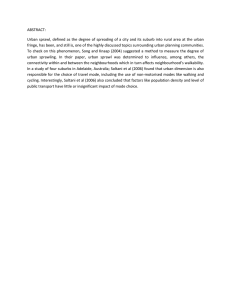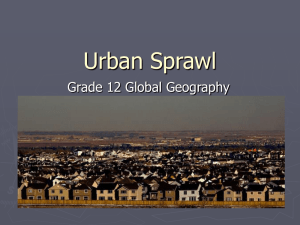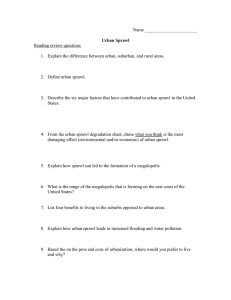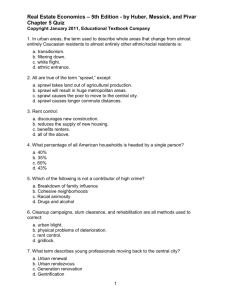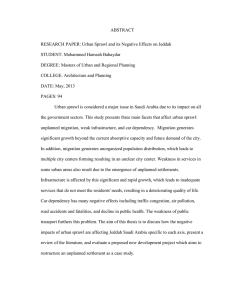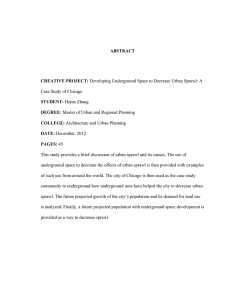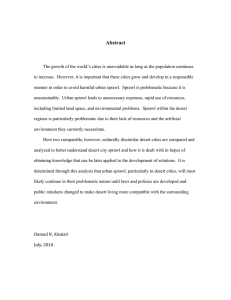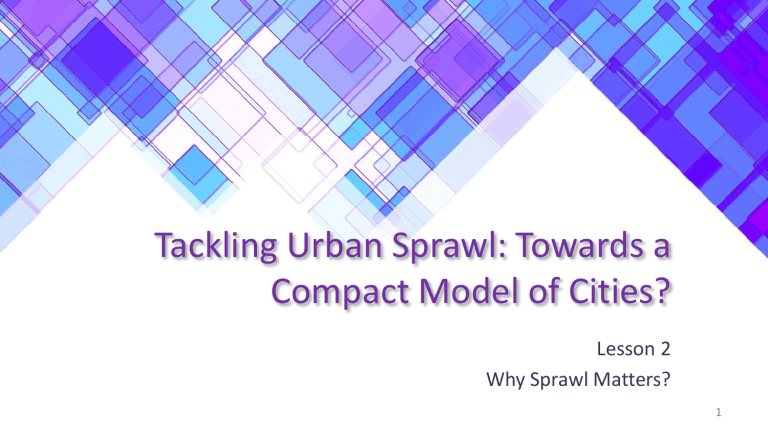
Tackling Urban Sprawl: Towards a Compact Model of Cities? Lesson 2 Why Sprawl Matters? 1 Why Sprawl Matters? • • • • • Sprawl creates environmental, social and economic impacts for both the cities and countryside of Europe Seriously undermines efforts to meet the global challenge of climate change Synonymous with unplanned incremental urban development characterized by low density mix of land uses on the urban fringe Classically, urban sprawl is a US phenomenon associated with the rapid low density outward expansion of US cities fueled by the rapid growth of private car ownership and the preference for detached houses with gardens European cities have traditionally been much more compact, developing a dense historical core shaped before the emergence of modern transport systems 2 Why Sprawl Matters? • • • • But today urban sprawl is a common phenomenon throughout Europe and there is no apparent slowing in these trends - urban areas particularly at risk include southern, eastern and central parts of Europe Sprawling nature of Europe's cities is critically important because of the major impacts evident in increased energy, land and soil consumption Impacts that threaten both the natural and rural environments, raising greenhouse gas emissions that cause climate change, and elevated air and noise pollution levels which exceed agreed human safety limits Urban sprawl produces many adverse impacts that have direct effects on the quality of life for people living in cities 3 Why Sprawl Matters? 4 Why are Cities Sprawling? • Historically, growth of cities driven by increasing urban • population – but in Europe today, even where there is little or no population pressure, a variety of factors are still driving. • These are rooted in the desire to realize new lifestyles in suburban environments, outside the inner city. Global socio-economic forces are interacting with more localized environmental and spatial constraints to generate the common characteristics of urban sprawl evident throughout Europe today. Sprawl has accelerated in response to improved transportation links and enhanced personal mobility – making it possible to live increasingly far from city centers, while retaining all the advantages of a city location, or to live in one city and work in another. Sprawl has accelerated in response to improved transportation links and enhanced personal mobility – making it possible to live increasingly far from city centers, while retaining all the advantages of a city location, or to live in one city and work in another. 5 Why are Cities Sprawling? • Mix of forces include both micro and macro socio-economic trends such as the means of transportation, price of land, individual housing preferences, demographic trends, cultural traditions and constraints, attractiveness of existing urban areas, and, not least, the application of land use planning policies • Overall, evidence suggests that where unplanned, decentralized development dominates, sprawl will occur in a mechanistic way • Conversely, where growth around the periphery of the city is coordinated by strong urban policy, more compact forms of urban development can be secured 6 7 Compact City Solutions Dense and proximate development patterns • • • • Urban land is intensively utilized Urban agglomerations are contiguous or close together Distinct border between urban and rural land use Public spaces are secured Urban areas linked by public transport systems • • Effective use of urban land Public transport systems facilitate mobility in urban areas Accessibility to local services and jobs • • Land use is mixed Most residents have access to local services either on foot or using public transport .... not only for smalland medium-sized cities, but it is relevant to cities of all sizes, even to mega-cities! 8 Compact Urban Sustainability Environmental benefits • Shorter inter-urban distances and less automobile dependency help reduce energy consumption and CO2 emissions • Conserve farmland and natural biodiversity around urban areas Economic benefits • Increase efficiency of infrastructure investment and reduce the cost of maintenance, particularly for line systems (transport, energy and water supply, waste disposal etc.) • Easier access to the diversity of local services and jobs • Generates new green needs that promote technological development and innovation, and thus stimulate growth Social benefits • Shorter travel distances on public transport systems - lower travel costs - facilitates the mobility of low-income households • Local services and jobs nearby contribute to a better quality of life 9 Policy responses 7th EAP provides an EU vision for land and soil and city management for 2020 and beyond: Priority 1: to protect, conserve and enhance the EU’s natural capital. Objective by 2020: “Land is managed sustainably in the Union, soil is adequately protected and the remediation of contaminated sites is well underway;” Priority 2: To turn the EU into a resource-efficient, green and competitive low carbon economy Priority 3: To safeguard EU citizens from environmental-related pressures and risks to health and wellbeing Priority 9: To enhance the sustainability of the Union’s cities. Objective by 2020: “a majority of cities in the Union are implementing policies for sustainable urban planning and design, including innovative approaches for urban public transport and mobility, sustainable buildings, energy efficiency and urban 10 biodiversity conservation”. Policy Responses EU Roadmap to a Resource Efficient Europe milestone on land and soil: 'By 2020, EU policies take into account their direct and indirect impact on land use in the EU and globally, and the rate of land take is on track with an aim to achieve no net land take by 2050 DG Regional and Urban Policy – developing the EU Urban Agenda Cohesion Policy 2014- 2020 Reinforcement of integrated urban policies in order to strengthen the role of cities EU initiatives for cities such as European Green Capital Award, Covenant of Mayors, EU Cities Adapt project, European Sustainable Cities Platform, and Smart Cities Innovation Partnership 11 Policy Strategies • Set explicit compact city goals • Encourage dense and contiguous development at urban fringes • Retrofit existing built-up areas – brownfield sites • Enhance diversity and quality of life in urban centers • Minimize adverse negative effects • Seek win-win solutions via city management 12 Urban Management Challenges But complexity of city management Drivers of change – global and local Finite resources and resource efficiency Climate change impacts and environmental vulnerability Demographic change and social cohesion Economic and financial crisis Complex conditions for urban management Interconnectedness of social, economic and environmental challenges in urban context Barriers to management sustainable urban development 13 Urban Management Challenges But complexity of city management Drivers of change – global and local Finite resources and resource efficiency Climate change impacts and environmental vulnerability Demographic change and social cohesion Economic and financial crisis Complex conditions for urban management Interconnectedness of social, economic and environmental challenges in urban context Barriers to management sustainable urban development 14 Delivering Compact City Solutions • • • Urban governance principles – green economy and sustainable development Integrated decision making Smart city solutions 15 Urban Governance Principles – Green Economy Ecosystem (Natural Capital) Economy (Produced Capital) Goal: ensure ecosystem resilience Goal: improve resource efficiency Human well-being: (social and human capital) Goal: Enhance social equity and fair burden-sharing 16 Integrated flexible multi-scalar governance 17 Integrated decision making Evaluation and Reporting Core Document: Evaluation Report (Update of) Baseline Review Core Document: Sustainability Report Implementation and Monitoring Core Document: Sustainability Program Target Setting Core Document: Sustainability Targets Political Commitment Core Document: Council Approval 18 Smart City Solutions Smartly Governed Cities Focus on the Need for • Information and intelligence to support decision- making regarding alternative options for the development of the community • EU project experience – ICT enabled urban governance • to support assessment of socio-economic and environmental impacts of territorial development • to support stakeholder engagement regarding alternative development options • to support political decision making and plan implementation 19 Smart Town Planning 20 EU Smart City Projects • • URBIS (ICT- PSP) Urban Atlas (ESA/EU) 21 URBIS (ICT- PSP) • • • • • Focus – brownfield/vacant land identification – alternatives to greenfield development Supported by common Pan-European land development potential assessment and reuse strategies Delivered by development of Urban Atlas for 310 largest cities of Europe Operational local level services – urban planners and development industry Strategic Pan-European services - EU level and development industry applications 22 Urban Atlas 23 Urban Atlas Copernicus operational services (ESA/EU) • • • Urban Atlas operational service offering highly detailed urban land use maps for the largest (310) city-regions in Europe (EU28) Urban Atlas provides pan-European, common and comparable land-use classification of cityregions Allowing comparison of information on density residential areas, commercial and industrial zones, extent of green areas, exposure to flood risks, and monitoring of urban sprawl 24 Urban sprawl – Policy Conclusions • Controlling urban sprawl, reusing vacant land, maintaining urban density, in order to provide the financial basis for public transport • Increased use of public transport in cities to secure policy co-benefits of GHG reduction, energy savings - and also healthy cities • Urban sprawl model of the management of land use - transport relationship – secures policy co-benefits increasing public transport • Solutions articulated by the land use - transport relationship –reinforcing the need for integrated management of the territory via spatial planning • Policy solutions emphasize the interconnectedness of drivers of change, pressures and environmental impacts 25 Thank You! 26
